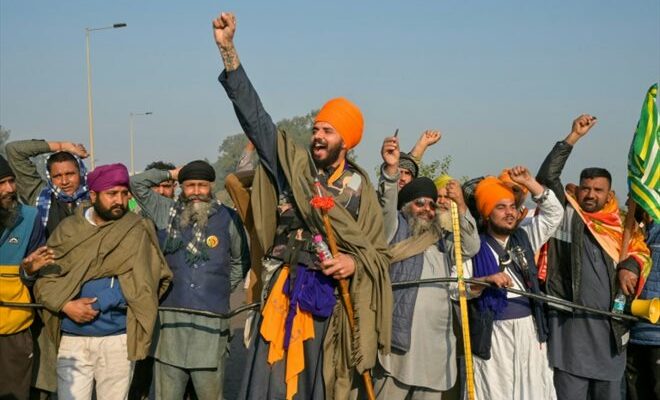Farmers block railway tracks during a demonstration to demand minimum prices for crops, at a train station in Rajpura, on February 15, 2024 in India (AFP/Narinder NANU)
Thousands of Indian farmers are converging on New Delhi on tractors this week, trying to revive the 2020-2021 protest movement that blocked highways to the capital for more than a year.
Prime Minister Narendra Modi was then forced to back down and repeal laws deregulating agricultural markets.
Farm unions say the government has since not done enough to resolve their problems, prompting them to resume their movement.
Columns of riot police have so far slowed the advance of protesters with tear gas and concrete barricades, but the farmers have vowed to continue their movement.
– What is the situation of the agricultural sector in India? –
The Indian agricultural sector is gigantic and mired in multiple difficulties. It employs more than 45% of the country’s workforce and represents 15% of its gross domestic product (GDP).
The “Green Revolution” of the 1970s made India, then regularly faced with food shortages, a major exporter of food products.
But for several decades, Indian agricultural incomes have largely stagnated and the sector is in acute need of investment and modernization.
The average size of farms remains modest: more than 85% of farmers own less than two hectares of land. And less than one in a hundred farmers own more than 10 hectares, according to a 2015-2016 Ministry of Agriculture survey.
Water shortages, flooding and erratic weather conditions linked to climate change, as well as debt are taking a heavy toll on farmers.
More than 300,000 of them have committed suicide since the 1990s, according to official figures, and many farmers deplore a state of constant financial distress.
“We work long hours in the fields and we still struggle to make ends meet,” Sandeep Kumar, 40, on the front line of the demonstration on Wednesday, told AFP.
Indian farmers nevertheless have significant political weight because of their numbers: tens of thousands of people had camped in the suburbs of Delhi during the previous movement to demand that the government of Narendra Modi abandon its plan to deregulate agriculture.
– What are farmers asking for? –
Indian farmers already have long-standing guarantees requiring the government to buy certain commodities, including rice and wheat, when their price falls below a certain level in the market.

Police and members of the Rapid Action Force (RAF) fire tear gas and block a highway to prevent farmers from marching towards New Delhi, on February 14, 2024 near Ambala, India (AFP/Narinder NANU)
The main demand of the unions is to extend these minimum support prices to all crops to protect them from market fluctuations.
The Modi government had promised to consider this request after the 2021 protests, but unions say nothing has been done since.
They also want charges against union leaders dating back to those protests to be dropped and a $120 monthly pension to be paid to farmers over 60.
Several other demands seek greater protection for farmers in the face of market fluctuations: debt relief, India’s withdrawal from the World Trade Organization (WTO) and free trade agreements, as well as assurance that Existing subsidies, including free electricity, will not be removed.
– What was the government’s response? –
India already spends more than $50 billion a year on subsidies to farmers, according to budget documents.

Farmers’ demonstration in Patiala, February 15, 2024 in India (AFP/Narinder NANU)
These subsidies have sometimes worsened the lack of productivity by encouraging crops unsuitable for local conditions, such as rice which has depleted groundwater in the state of Punjab.
Subsidies and public purchases of agricultural products have frequently been sources of corruption and waste.
The government held several rounds of negotiations with unions this week to defuse the crisis, without success.
Mr Modi’s party, the BJP, says the extension of the minimum price system is regressive and unaffordable, with an estimated cost of at least an additional $140 billion.
The government instead sought to contain the demonstrations in order to avoid a large-scale movement like that of 2020-2021, which had aroused great sympathy in public opinion.
© 2024 AFP
Did you like this article ? Share it with your friends using the buttons below.




